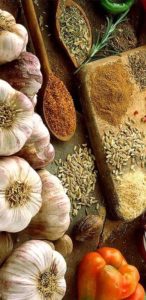
Medicinal and culinary herbs are rich sources of anti-inflammatory antioxidants, especially flavonoids. They also contain trace amounts of natural Cox-2 inhibitors, such as salicylates.
Medicinal herbs can be especially potent, while culinary herbs are perhaps less potent but more tasty anti-inflammatory nutrients. Over the past several years herbal medicines have moved from folk-medicine status to scientifically supported treatments.
We have a huge number of herbs and spices and their beneficial use in various ailments, the links are spread across these 5 pages, towards the bottom of the page:
These are some of the most popular:
 Major drug companies routinely fund expeditions to the Amazon and other undeveloped regions to identify new plants and potentially therapeutic molecules. Almost half of all modern drugs have either been developed from plant compounds or are synthetic replicas of molecules found in plants.
Major drug companies routinely fund expeditions to the Amazon and other undeveloped regions to identify new plants and potentially therapeutic molecules. Almost half of all modern drugs have either been developed from plant compounds or are synthetic replicas of molecules found in plants.
Unlike pharmaceutical drugs, which are usually built around a single synthetic molecule, herbs may contain hundreds if not thousands of active principles. The diversity and frequent synergism of these anti-inflammatory compounds lead to a multifaceted biochemical attack on inflammation, instead of overwhelming a single biochemical pathway and causing side effects. In fact, many of the substances in herbs are also found in common fruits and vegetables, which means they have historically played a role in human nutrition and evolution.
Indeed, the anti-inflammatory nutrients in fruits, vegetables, and herbs may have historically helped control excessive inflammation.
